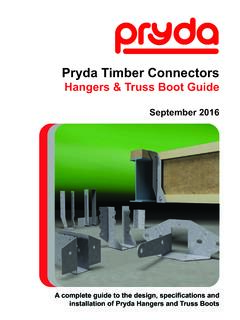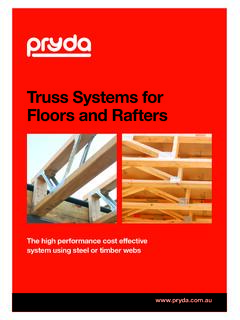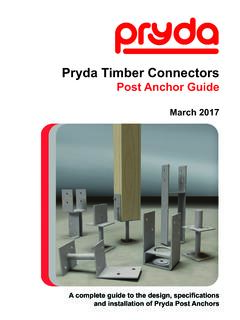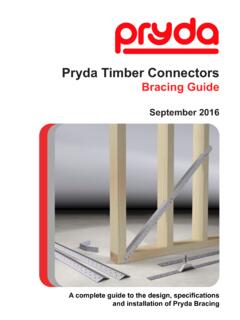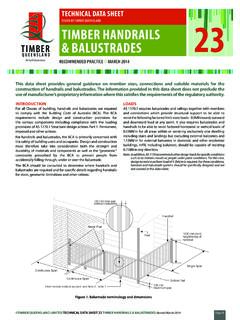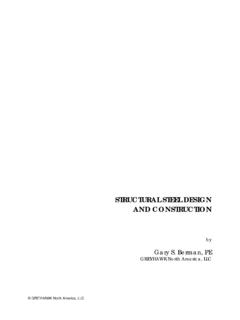Transcription of Pryda Timber Connectors
1 Pryda Timber ConnectorsNailplates GuideSeptember 2016A complete guide to the design,specifications and installation of Pryda Nailplates ESSENTIAL NOTES Pryda PRODUCT GUIDES Copyright: Pryda Australia - A Division of ITW Australia ABN 63 004 235 063 - 2016 INTRODUCTION The information in this Product Guide is provided for use in Australia by architects, engineers, building designers, builders and others. It is based upon the following criteria: 1. No Substitution: The products covered by or recommended in this guide must not be substituted with other products. 2. Design Capacity Basis: See Codes & Standards following.
2 3. Supporting Constructions: Constructions using Pryda products must be built in accordance with the NCC (BCA) or an appropriate australian Standard. Note: This includes appropriate corrosion protection- See Corrosion Protection following. 4. Correct Installation: Installation of Pryda products must be strictly in accordance with the instructions in this guide. 5. Current Guide Version Used: The current version of this guide, including any amendments or additions, must be used. Users are advised to check the Pryda website, , on a regular basis for the most current design guides.
3 CODES & STANDARDS Product design capacities in this guide have been derived from: (a) Results of laboratory tests carried out by or for Pryda Australia (b) Engineering computations in accordance with the relevant australian Standards, ie: Timber Structures. Part 1: Design Methods. AS/NZS1170 series Structural Design Actions. AS4055-2006 Wind Loads for Housing. Design capacities tabulated in this guide apply directly for Category 1 joints. For all other joints, reduce design capacities by using the factors as specified in General Notes (if applicable). Design capacities are related to the Joint Group of the Timber as defined in AS1720 and AS1684.
4 If the Joint Group of Timber members joined together varies, the lower group must be assumed for design, for example, JD5 is lower than JD4. DEFINITIONS Special terms used in this guide are as defined in australian Standards, including: Design Capacity: The maximum Limit State Design load (aka action ) which the product can safely support under the specified load condition, eg, + (dead+roof live). See General Notes for details (if applicable). Joint Group: Classification of a Timber according to its fastener-holding capacity. See General Notes for details (if applicable) CORROSION PROTECTION Most Pryda products are manufactured using Z275 light-gauge steel, having zinc coating of 275 gsm (total weight).
5 This protection is adequate only for INTERNAL applications in most corrosive environments, except areas that are classified as heavy industrial or those subject to high humidity (eg, enclosed swimming pools). Under these circumstances, seek advice from experts as special protection will be required. Note: INTERNAL areas are those within the building envelope that are kept permanently dry. and , australian Standards for residential Timber Frame Construction stipulate a minimum Z275 steel for all sheet metal products used in an internal environment. In areas outside the building envelope that are exposed to repeated wetting (EXTERNAL areas), Pryda s stainless steel products or equivalent should be considered.
6 Some alternatives include hot dip galvanised or powder coated steel, which are not supplied by Pryda . For more detailed information, read Pryda s Technical Update on Corrosion Resistance of Pryda Products or contact a Pryda office. PRODUCT CERTIFICATION Pryda Australia warrants: Products in this guide are free from defects in the material and manufacturing Design capacities are in accordance with test results or current, relevant australian Standards and the Building Code of Australia. Pryda products are structurally adequate provided they are designed, installed and used completely in accordance with this guide.
7 This warranty applies only to: Products in this guide. Products used in the specified applications and not damaged after manufacture and supply. Joints free from wood splitting, decay or other Timber defects at the joint or within 150 mm of the joint. INSTRUCTIONS FOR INSTALLATION These notes are provided to ensure proper installation. 1. All fasteners used must be manufactured by reputable companies and be of structural quality. 2. Connectors must not be installed on Timber which is split before or during installation. If the Timber is likely to split as fasteners are driven, fastener holes must be pre-drilled.
8 3. Do not overload the joints during construction or in service. 4. Hole diameter for bolts in seasoned Timber must not be more than mm larger than the bolt diameter to achieve a snug-tight connection. Specified washers must be installed against the Timber face. 5. Use proper safety equipment and due care in installing these Connectors . 6. Any gaps in joints between the Timber members must not exceed 3 mm. 7. Do not over-tighten screws. Pryda Nailplates Guide TABLE OF CONTENTS GENERAL NOTES Useful Notes and Definitions for effective reading of this guide 4 CONNECTOR PLATES Quick and easy butt joint connector 5 CORNER PLATE Bracket for right angle joints 6 KNUCKLE NAILPLATES STANDARD & SPECIAL Hammer applied nailplates for many joint types Special types for specific uses 7 MININAIL Claw Nailplate for simple butt joints 9 NAIL-ON PLATES Connector plates for joints with Pryda Timber Connector Nails 10 POLE CATS Anti-split nailplates for ends of poles and posts 12 STRAP NAILS Connector
9 Plates with built-in Claw Nails 12 Product Information Updates Information contained in this product guide is subject to change. The latest updates are available from Pryda Timber Connectors Nailplates Guide 4 Pryda NAILPLATES GUIDE SEPTEMBER 2016 GENERAL NOTES Timber Joint Groups Joint groups for some common Timber are tabulated below. A more comprehensive table is given in : 2010. Timbers Strength Group Joint Group Dry Green Dry Green Oregon (Douglas fir) America SD5 S5 JD4 J4 Oregon from elsewhere SD6 S6 JD5 J5 Radiata pine, heart-excluded SD6 NA JD4 NA Radiata pine, heart-in SD6 NA JD5 NA Slash pine SD5 S5 JD3 J3 Ash type hardwoods from Vic, NSW highlands & Tas SD4 S4 JD3 J3 Non-Ash type hardwoods from Qld & NSW SD3 S3 JD2 J2 Note on Engineered Timbers: Most standard LVLs are assigned a JD4 joint group, and some JD3.
10 Seek advice from the relevant LVL manufacturer for confirmation. Design Load Cases Following is a description of the combined load cases adopted in this design guide. These load cases are in compliance with :2002 Structural design actions Part 0:General principles. Design Loads & Capacities The tabulated capacities are for Category 1 joints as described in Table of :2010. For joints in other Categories, reduce design capacities by using the following factors: Category 2 Joints: Category 3 Joints: Category 1 joints are defined in Table :2010 as structural joints for houses for which failure would be unlikely to affect an area of 25 sqm OR joints for secondary elements in structures other than houses.
